technical specifications FIAT DUCATO 2007 Owner handbook (in English)
[x] Cancel search | Manufacturer: FIAT, Model Year: 2007, Model line: DUCATO, Model: FIAT DUCATO 2007Pages: 282, PDF Size: 4.49 MB
Page 195 of 282
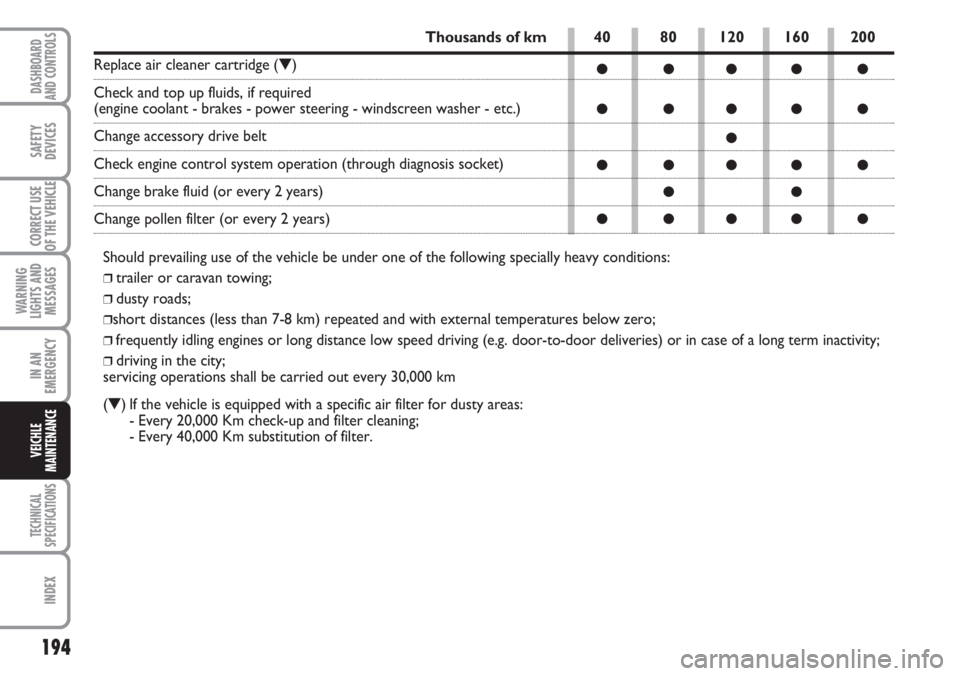
194
WARNING
LIGHTS AND
MESSAGES
TECHNICAL
SPECIFICATIONS
INDEX
DASHBOARD
AND CONTROLS
SAFETY
DEVICES
CORRECT USE
OF THE VEHICLE
IN AN
EMERGENCY
VEICHLE
MAINTENANCE
40 80 120 160 200
●●●●●
●●●●●
●
●●●●●
●●
●●●●●
Thousands of km
Replace air cleaner cartridge (▼)
Check and top up fluids, if required
(engine coolant - brakes - power steering - windscreen washer - etc.)
Change accessory drive belt
Check engine control system operation (through diagnosis socket)
Change brake fluid (or every 2 years)
Change pollen filter (or every 2 years)
Should prevailing use of the vehicle be under one of the following specially heavy conditions:
❒trailer or caravan towing;
❒dusty roads;
❒short distances (less than 7-8 km) repeated and with external temperatures below zero;
❒frequently idling engines or long distance low speed driving (e.g. door-to-door deliveries) or in case of a long term inactivity;
❒driving in the city;
servicing operations shall be carried out every 30,000 km
(▼) If the vehicle is equipped with a specific air filter for dusty areas:
- Every 20,000 Km check-up and filter cleaning;
- Every 40,000 Km substitution of filter.
Page 196 of 282
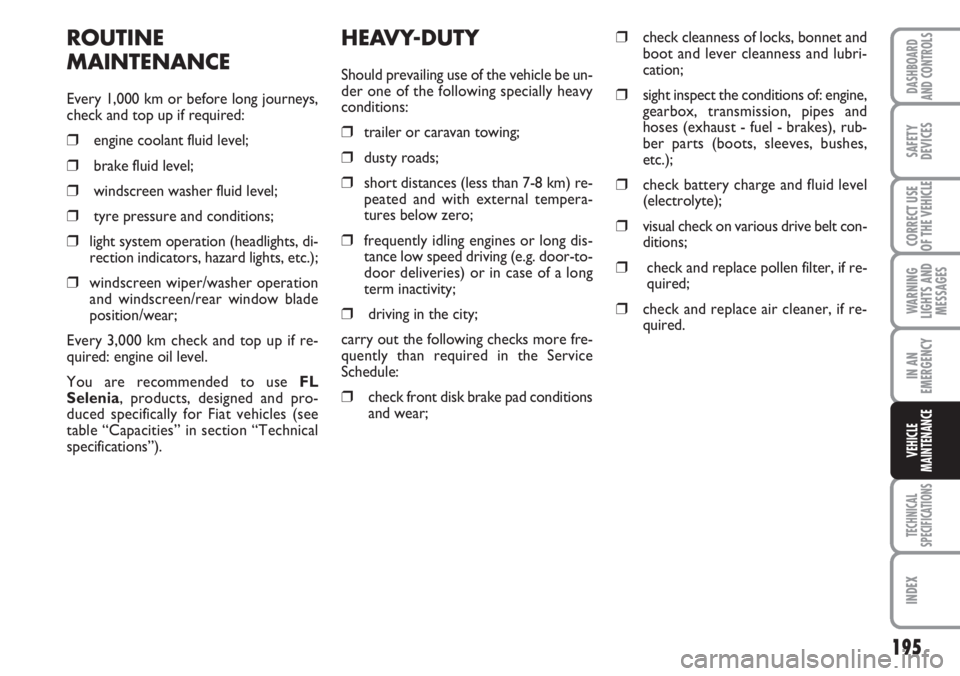
195
WARNING
LIGHTS AND
MESSAGES
TECHNICAL
SPECIFICATIONS
INDEX
DASHBOARD
AND CONTROLS
SAFETY
DEVICES
CORRECT USE
OF THE VEHICLE
IN AN
EMERGENCY
VEHICLE
MAINTENANCE
HEAVY-DUTY
Should prevailing use of the vehicle be un-
der one of the following specially heavy
conditions:
❒trailer or caravan towing;
❒dusty roads;
❒short distances (less than 7-8 km) re-
peated and with external tempera-
tures below zero;
❒frequently idling engines or long dis-
tance low speed driving (e.g. door-to-
door deliveries) or in case of a long
term inactivity;
❒driving in the city;
carry out the following checks more fre-
quently than required in the Service
Schedule:
❒check front disk brake pad conditions
and wear;
❒check cleanness of locks, bonnet and
boot and lever cleanness and lubri-
cation;
❒sight inspect the conditions of: engine,
gearbox, transmission, pipes and
hoses (exhaust - fuel - brakes), rub-
ber parts (boots, sleeves, bushes,
etc.);
❒check battery charge and fluid level
(electrolyte);
❒visual check on various drive belt con-
ditions;
❒check and replace pollen filter, if re-
quired;
❒check and replace air cleaner, if re-
quired.
ROUTINE
MAINTENANCE
Every 1,000 km or before long journeys,
check and top up if required:
❒engine coolant fluid level;
❒brake fluid level;
❒windscreen washer fluid level;
❒tyre pressure and conditions;
❒light system operation (headlights, di-
rection indicators, hazard lights, etc.);
❒windscreen wiper/washer operation
and windscreen/rear window blade
position/wear;
Every 3,000 km check and top up if re-
quired: engine oil level.
You are recommended to use FL
Selenia, products, designed and pro-
duced specifically for Fiat vehicles (see
table “Capacities” in section “Technical
specifications”).
Page 197 of 282
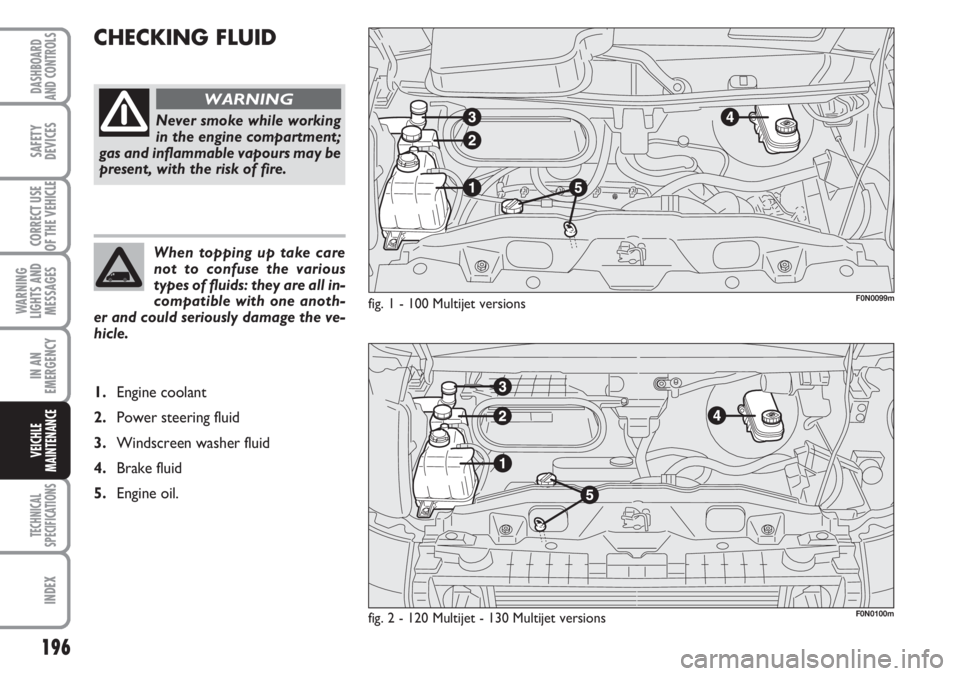
196
WARNING
LIGHTS AND
MESSAGES
TECHNICAL
SPECIFICATIONS
INDEX
DASHBOARD
AND CONTROLS
SAFETY
DEVICES
CORRECT USE
OF THE VEHICLE
IN AN
EMERGENCY
VEICHLE
MAINTENANCE
CHECKING FLUID
fig. 1 - 100 Multijet versions
Never smoke while working
in the engine compartment;
gas and inflammable vapours may be
present, with the risk of fire.
WARNING
When topping up take care
not to confuse the various
types of fluids: they are all in-
compatible with one anoth-
er and could seriously damage the ve-
hicle.
1.Engine coolant
2.Power steering fluid
3.Windscreen washer fluid
4.Brake fluid
5.Engine oil.
F0N0099m
fig. 2 - 120 Multijet - 130 Multijet versionsF0N0100m
Page 198 of 282
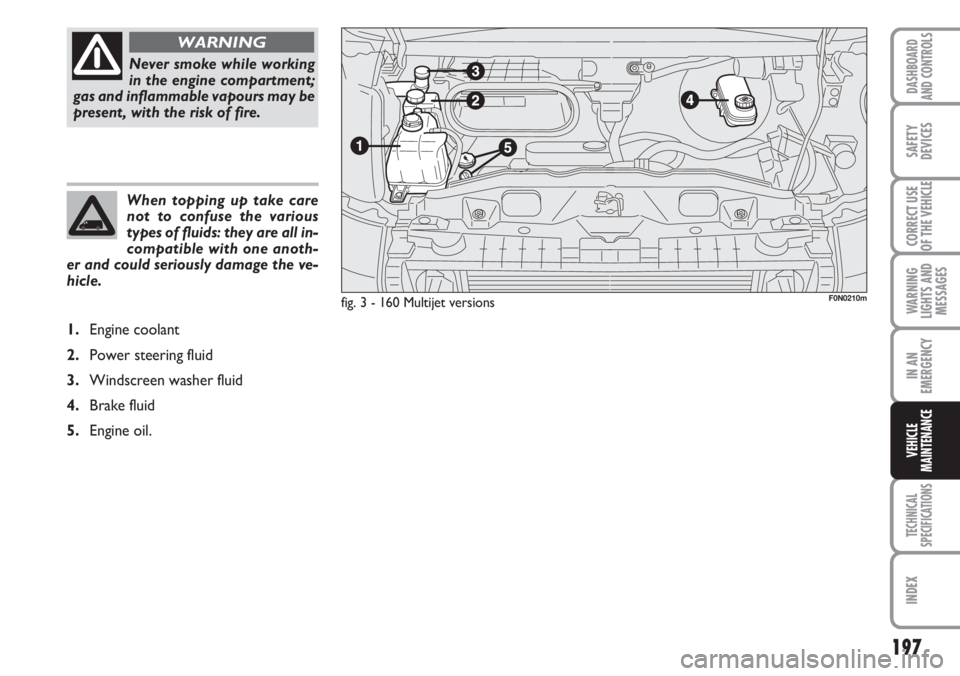
197
WARNING
LIGHTS AND
MESSAGES
TECHNICAL
SPECIFICATIONS
INDEX
DASHBOARD
AND CONTROLS
SAFETY
DEVICES
CORRECT USE
OF THE VEHICLE
IN AN
EMERGENCY
VEHICLE
MAINTENANCE
When topping up take care
not to confuse the various
types of fluids: they are all in-
compatible with one anoth-
er and could seriously damage the ve-
hicle.
fig. 3 - 160 Multijet versionsF0N0210m
1.Engine coolant
2.Power steering fluid
3.Windscreen washer fluid
4.Brake fluid
5.Engine oil.
Never smoke while working
in the engine compartment;
gas and inflammable vapours may be
present, with the risk of fire.
WARNING
Page 199 of 282
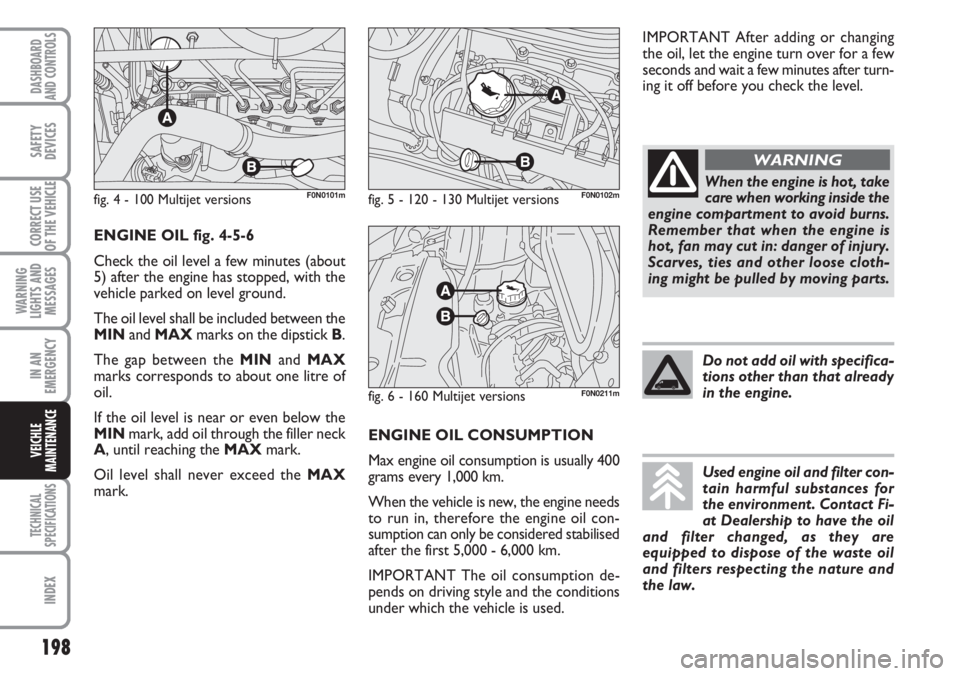
198
WARNING
LIGHTS AND
MESSAGES
TECHNICAL
SPECIFICATIONS
INDEX
DASHBOARD
AND CONTROLS
SAFETY
DEVICES
CORRECT USE
OF THE VEHICLE
IN AN
EMERGENCY
VEICHLE
MAINTENANCE
ENGINE OIL CONSUMPTION
Max engine oil consumption is usually 400
grams every 1,000 km.
When the vehicle is new, the engine needs
to run in, therefore the engine oil con-
sumption can only be considered stabilised
after the first 5,000 - 6,000 km.
IMPORTANT The oil consumption de-
pends on driving style and the conditions
under which the vehicle is used. ENGINE OIL fig. 4-5-6
Check the oil level a few minutes (about
5) after the engine has stopped, with the
vehicle parked on level ground.
The oil level shall be included between the
MINand MAXmarks on the dipstick B.
The gap between the MINand MAX
marks corresponds to about one litre of
oil.
If the oil level is near or even below the
MINmark, add oil through the filler neck
A, until reaching the MAXmark.
Oil level shall never exceed the MAX
mark.
fig. 4 - 100 Multijet versionsF0N0101mfig. 5 - 120 - 130 Multijet versions
fig. 6 - 160 Multijet versionsF0N0102m
F0N0211m
When the engine is hot, take
care when working inside the
engine compartment to avoid burns.
Remember that when the engine is
hot, fan may cut in: danger of injury.
Scarves, ties and other loose cloth-
ing might be pulled by moving parts.
WARNING
Do not add oil with specifica-
tions other than that already
in the engine.
Used engine oil and filter con-
tain harmful substances for
the environment. Contact Fi-
at Dealership to have the oil
and filter changed, as they are
equipped to dispose of the waste oil
and filters respecting the nature and
the law.
IMPORTANT After adding or changing
the oil, let the engine turn over for a few
seconds and wait a few minutes after turn-
ing it off before you check the level.
Page 200 of 282
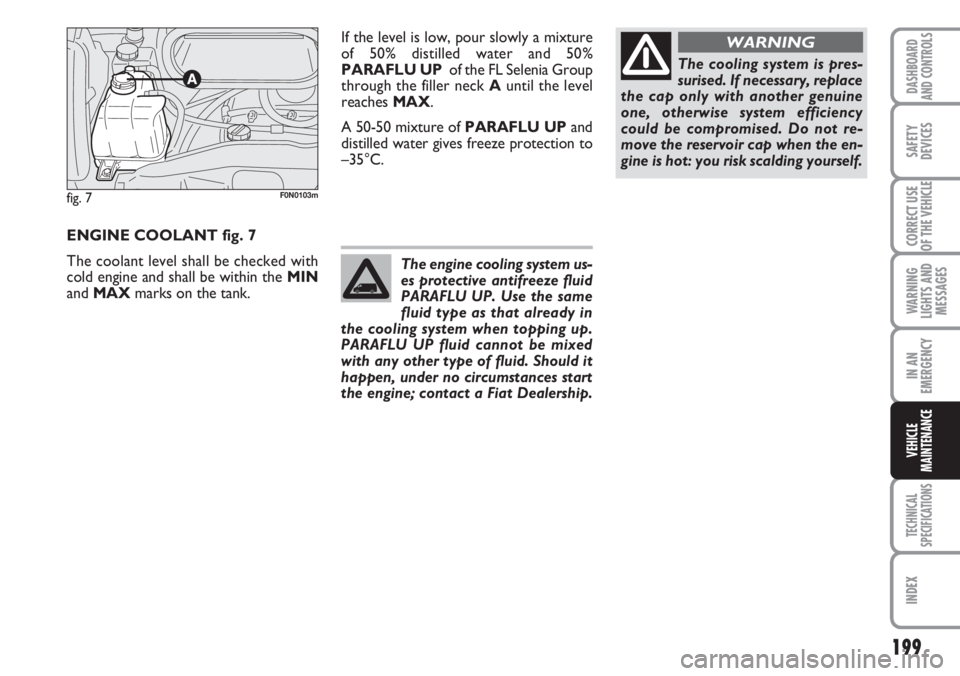
199
WARNING
LIGHTS AND
MESSAGES
TECHNICAL
SPECIFICATIONS
INDEX
DASHBOARD
AND CONTROLS
SAFETY
DEVICES
CORRECT USE
OF THE VEHICLE
IN AN
EMERGENCY
VEHICLE
MAINTENANCE
ENGINE COOLANT fig. 7
The coolant level shall be checked with
cold engine and shall be within the MIN
and MAXmarks on the tank.
fig. 7F0N0103m
If the level is low, pour slowly a mixture
of 50% distilled water and 50%
PARAFLU UP of the FL Selenia Group
through the filler neck Auntil the level
reaches MAX.
A 50-50 mixture of PARAFLU UPand
distilled water gives freeze protection to
–35°C.
The engine cooling system us-
es protective antifreeze fluid
PARAFLU UP. Use the same
fluid type as that already in
the cooling system when topping up.
PARAFLU UP fluid cannot be mixed
with any other type of fluid. Should it
happen, under no circumstances start
the engine; contact a Fiat Dealership.
The cooling system is pres-
surised. If necessary, replace
the cap only with another genuine
one, otherwise system efficiency
could be compromised. Do not re-
move the reservoir cap when the en-
gine is hot: you risk scalding yourself.
WARNING
Page 201 of 282
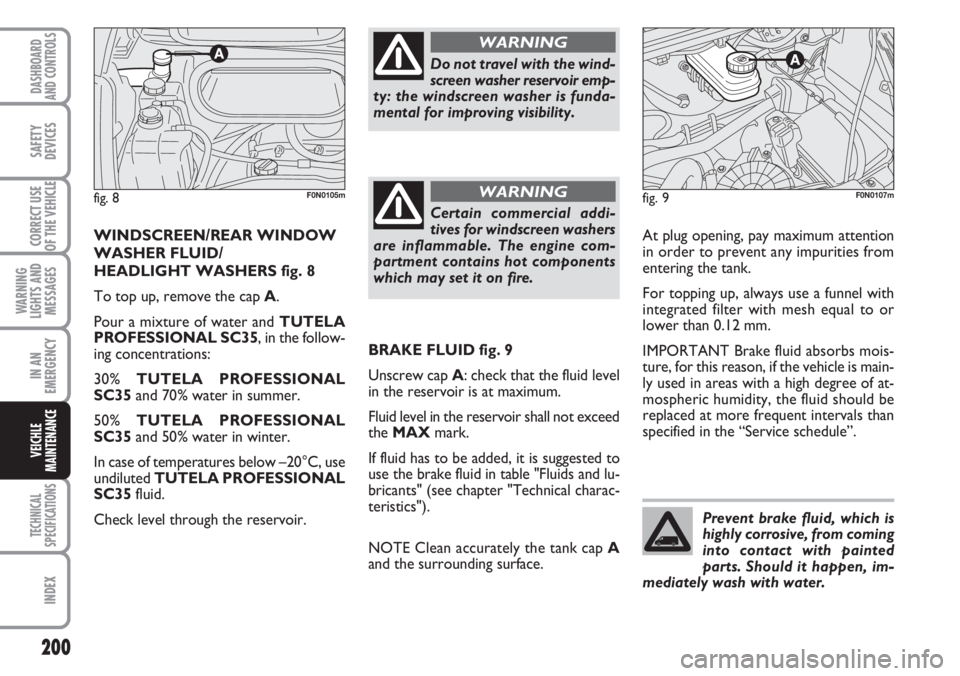
Prevent brake fluid, which is
highly corrosive, from coming
into contact with painted
parts. Should it happen, im-
mediately wash with water.
200
WARNING
LIGHTS AND
MESSAGES
TECHNICAL
SPECIFICATIONS
INDEX
DASHBOARD
AND CONTROLS
SAFETY
DEVICES
CORRECT USE
OF THE VEHICLE
IN AN
EMERGENCY
VEICHLE
MAINTENANCE
At plug opening, pay maximum attention
in order to prevent any impurities from
entering the tank.
For topping up, always use a funnel with
integrated filter with mesh equal to or
lower than 0.12 mm.
IMPORTANT Brake fluid absorbs mois-
ture, for this reason, if the vehicle is main-
ly used in areas with a high degree of at-
mospheric humidity, the fluid should be
replaced at more frequent intervals than
specified in the “Service schedule”.
fig. 9F0N0107m
Do not travel with the wind-
screen washer reservoir emp-
ty: the windscreen washer is funda-
mental for improving visibility.
WARNING
Certain commercial addi-
tives for windscreen washers
are inflammable. The engine com-
partment contains hot components
which may set it on fire.
WARNING
WINDSCREEN/REAR WINDOW
WASHER FLUID/
HEADLIGHT WASHERS fig. 8
To top up, remove the cap A.
Pour a mixture of water and TUTELA
PROFESSIONAL SC35, in the follow-
ing concentrations:
30% TUTELA PROFESSIONAL
SC35and 70% water in summer.
50% TUTELA PROFESSIONAL
SC35and 50% water in winter.
In case of temperatures below –20°C, use
undiluted TUTELA PROFESSIONAL
SC35fluid.
Check level through the reservoir.
fig. 8F0N0105m
BRAKE FLUID fig. 9
Unscrew cap A: check that the fluid level
in the reservoir is at maximum.
Fluid level in the reservoir shall not exceed
the MAXmark.
If fluid has to be added, it is suggested to
use the brake fluid in table "Fluids and lu-
bricants" (see chapter "Technical charac-
teristics").
NOTE Clean accurately the tank cap A
and the surrounding surface.
Page 202 of 282
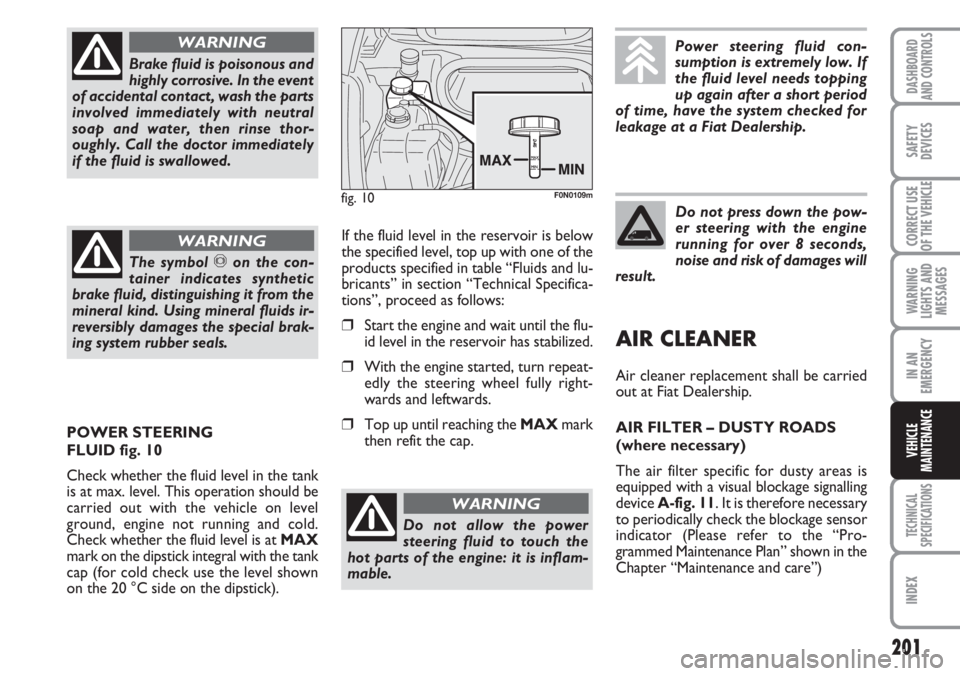
201
WARNING
LIGHTS AND
MESSAGES
TECHNICAL
SPECIFICATIONS
INDEX
DASHBOARD
AND CONTROLS
SAFETY
DEVICES
CORRECT USE
OF THE VEHICLE
IN AN
EMERGENCY
VEHICLE
MAINTENANCE
Brake fluid is poisonous and
highly corrosive. In the event
of accidental contact, wash the parts
involved immediately with neutral
soap and water, then rinse thor-
oughly. Call the doctor immediately
if the fluid is swallowed.
WARNING
The symbol πon the con-
tainer indicates synthetic
brake fluid, distinguishing it from the
mineral kind. Using mineral fluids ir-
reversibly damages the special brak-
ing system rubber seals.
WARNING
POWER STEERING
FLUID fig. 10
Check whether the fluid level in the tank
is at max. level. This operation should be
carried out with the vehicle on level
ground, engine not running and cold.
Check whether the fluid level is at MAX
mark on the dipstick integral with the tank
cap (for cold check use the level shown
on the 20 °C side on the dipstick).If the fluid level in the reservoir is below
the specified level, top up with one of the
products specified in table “Fluids and lu-
bricants” in section “Technical Specifica-
tions”, proceed as follows:
❒Start the engine and wait until the flu-
id level in the reservoir has stabilized.
❒With the engine started, turn repeat-
edly the steering wheel fully right-
wards and leftwards.
❒Top up until reaching the MAXmark
then refit the cap.
fig. 10F0N0109m
Do not allow the power
steering fluid to touch the
hot parts of the engine: it is inflam-
mable.
WARNING
Do not press down the pow-
er steering with the engine
running for over 8 seconds,
noise and risk of damages will
result.
Power steering fluid con-
sumption is extremely low. If
the fluid level needs topping
up again after a short period
of time, have the system checked for
leakage at a Fiat Dealership.
AIR CLEANER
Air cleaner replacement shall be carried
out at Fiat Dealership.
AIR FILTER – DUSTY ROADS
(where necessary)
The air filter specific for dusty areas is
equipped with a visual blockage signalling
device A-fig. 11. It is therefore necessary
to periodically check the blockage sensor
indicator (Please refer to the “Pro-
grammed Maintenance Plan” shown in the
Chapter “Maintenance and care”)
Page 203 of 282
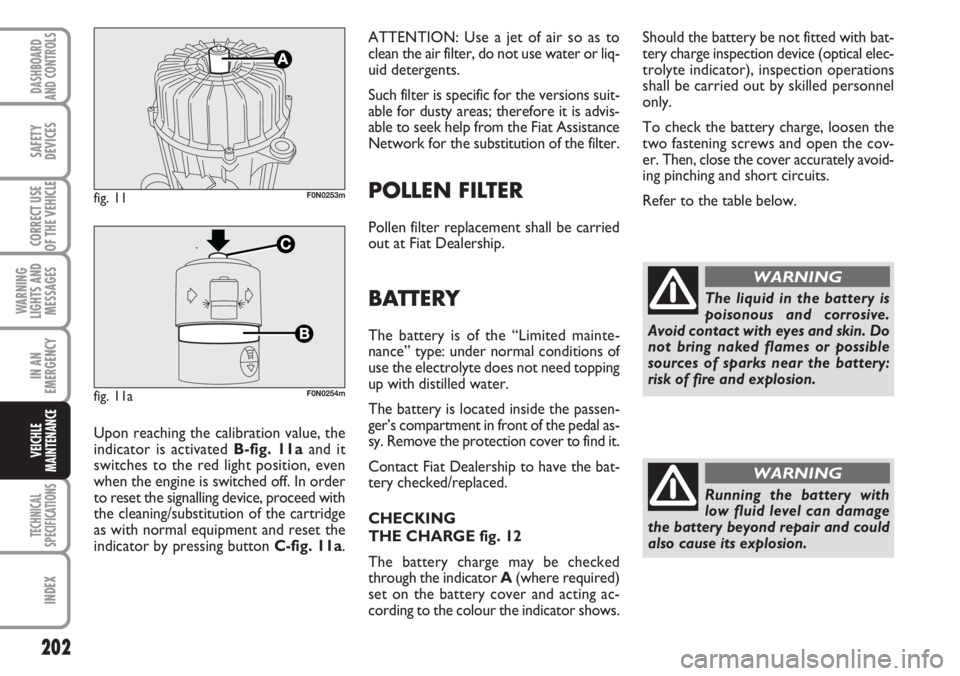
202
WARNING
LIGHTS AND
MESSAGES
TECHNICAL
SPECIFICATIONS
INDEX
DASHBOARD
AND CONTROLS
SAFETY
DEVICES
CORRECT USE
OF THE VEHICLE
IN AN
EMERGENCY
VEICHLE
MAINTENANCE
ATTENTION: Use a jet of air so as to
clean the air filter, do not use water or liq-
uid detergents.
Such filter is specific for the versions suit-
able for dusty areas; therefore it is advis-
able to seek help from the Fiat Assistance
Network for the substitution of the filter.
POLLEN FILTER
Pollen filter replacement shall be carried
out at Fiat Dealership.
BATTERY
The battery is of the “Limited mainte-
nance” type: under normal conditions of
use the electrolyte does not need topping
up with distilled water.
The battery is located inside the passen-
ger’s compartment in front of the pedal as-
sy. Remove the protection cover to find it.
Contact Fiat Dealership to have the bat-
tery checked/replaced.
CHECKING
THE CHARGE fig. 12
The battery charge may be checked
through the indicator A(where required)
set on the battery cover and acting ac-
cording to the colour the indicator shows.
The liquid in the battery is
poisonous and corrosive.
Avoid contact with eyes and skin. Do
not bring naked flames or possible
sources of sparks near the battery:
risk of fire and explosion.
WARNING
Running the battery with
low fluid level can damage
the battery beyond repair and could
also cause its explosion.
WARNING
Should the battery be not fitted with bat-
tery charge inspection device (optical elec-
trolyte indicator), inspection operations
shall be carried out by skilled personnel
only.
To check the battery charge, loosen the
two fastening screws and open the cov-
er. Then, close the cover accurately avoid-
ing pinching and short circuits.
Refer to the table below.
Upon reaching the calibration value, the
indicator is activated B-fig. 11aand it
switches to the red light position, even
when the engine is switched off. In order
to reset the signalling device, proceed with
the cleaning/substitution of the cartridge
as with normal equipment and reset the
indicator by pressing button C-fig. 11a.
fig. 11F0N0253m
fig. 11aF0N0254m
Page 204 of 282
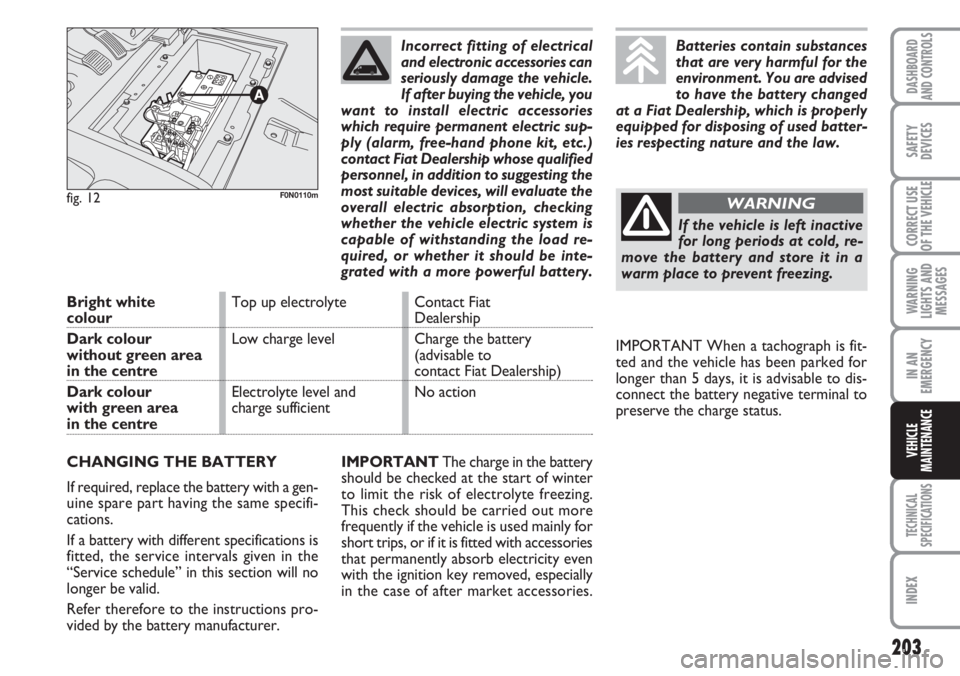
203
WARNING
LIGHTS AND
MESSAGES
TECHNICAL
SPECIFICATIONS
INDEX
DASHBOARD
AND CONTROLS
SAFETY
DEVICES
CORRECT USE
OF THE VEHICLE
IN AN
EMERGENCY
VEHICLE
MAINTENANCEIMPORTANTThe charge in the battery
should be checked at the start of winter
to limit the risk of electrolyte freezing.
This check should be carried out more
frequently if the vehicle is used mainly for
short trips, or if it is fitted with accessories
that permanently absorb electricity even
with the ignition key removed, especially
in the case of after market accessories.
fig. 12F0N0110m
Bright whiteTop up electrolyte Contact FiatcolourDealership
Dark colourLow charge level Charge the battery
without green area (advisable to
in the centrecontact Fiat Dealership)
Dark colour Electrolyte level and No action
with green area charge sufficient
in the centre
CHANGING THE BATTERY
If required, replace the battery with a gen-
uine spare part having the same specifi-
cations.
If a battery with different specifications is
fitted, the service intervals given in the
“Service schedule” in this section will no
longer be valid.
Refer therefore to the instructions pro-
vided by the battery manufacturer.Incorrect fitting of electrical
and electronic accessories can
seriously damage the vehicle.
If after buying the vehicle, you
want to install electric accessories
which require permanent electric sup-
ply (alarm, free-hand phone kit, etc.)
contact Fiat Dealership whose qualified
personnel, in addition to suggesting the
most suitable devices, will evaluate the
overall electric absorption, checking
whether the vehicle electric system is
capable of withstanding the load re-
quired, or whether it should be inte-
grated with a more powerful battery.
Batteries contain substances
that are very harmful for the
environment. You are advised
to have the battery changed
at a Fiat Dealership, which is properly
equipped for disposing of used batter-
ies respecting nature and the law.
If the vehicle is left inactive
for long periods at cold, re-
move the battery and store it in a
warm place to prevent freezing.
WARNING
IMPORTANT When a tachograph is fit-
ted and the vehicle has been parked for
longer than 5 days, it is advisable to dis-
connect the battery negative terminal to
preserve the charge status.